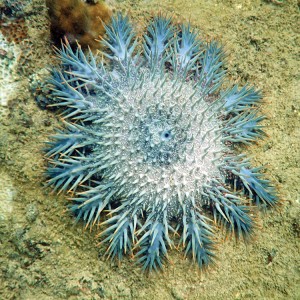A Spiny, Faceless Monster
Monday, May 16th, 2016Monster Monday
May 16, 2016
Every part of its body is coated in venomous spines. It can survive losing limbs, or even being cut it in half. Researchers are building robots to hunt it down and kill it. Is it an evil alien? No, it is the crown of thorns.
The crown of thorns is a starfish. Also called sea stars, starfish are not actually fish. They are star-shaped members of a group of invertebrates (animals without a backbone) called echinoderms. Other echinoderms include such marine animals as sand dollars, sea cucumbers, and sea urchins. The crown of thorns has 8 to 21 arms arranged around a central disk. Adults typically measure about 10 to 14 inches (25 to 35 centimeters) across, including the arms.
Crown of thorns starfish live on coral reefs in the Indian and Pacific oceans. Coral reefs are the most diverse habitats in the ocean, providing homes for fish, shrimp, snails, and echinoderms. Small, colonial organisms called corals build reefs by forming stony skeletons. Over hundreds of years, these skeletons grow and expand into huge rocky structures, creating hiding places for all kinds of animals.
The crown of thorns feeds on corals, using the tiny mouth on the underside of its body. It chews away the soft parts of the coral, leaving only the bare skeleton. In healthy reefs, these starfish are an important part of the ecosystem. Their feeding damages or kills corals, but it also makes room for new corals to grow, similar to the way forest fires clear room for young trees. In recent years, however, some reefs have suffered vast outbreaks of the starfish. In large numbers, crown of thorns destroy the reef, mowing down corals faster than they can be replaced.
Why does this starfish have a population that can grow too large and threaten the existence of the reefs upon which it depends? Scientists aren’t entirely sure, but they suspect the population booms stem from human activities. When farmers use fertilizers in their fields, rainwater washes some of them into the ocean. Tiny plantlike life forms called phytoplankton feed on these excess nutrients and reproduce rapidly, causing their populations to explode. Biologists think that crown of thorns larvae (young), which are very small, float around in the current and feast on the abundant phytoplankton, allowing more of them to survive into adulthood. When these larvae mature and become larger, they fall to the ocean bottom and begin to feed on coral reefs. Scientists also suspect that people have helped crown of thorns populations to explode by overfishing the starfish’s few natural predators.
More research needs to be conducted to determine the cause of crown of thorns outbreaks in order to prevent them. In the meantime, coastal communities are focusing on ways to stop the outbreaks. Divers collect the “monsters” and bring them onto land or inject them with a poison that doesn’t harm the environment. This is tricky work, however. The sharp spines can puncture wetsuits and skin with ease and release toxins that cause sharp pain and swelling for days or weeks. The spines are brittle, so they often break off inside the victim, requiring surgical removal.
To stop outbreaks, Queensland University of Technology engineers have created a robotic submarine immune to the spines. The sub is designed to move around a reef, identify crown of thorns starfish using machine learning, and inject them with poison. The robot can work for up to eight hours at a time—all without a human pilot—and identify its quarry with 99 percent accuracy. The subs have not yet been used, but they may soon be needed to protect coral reefs from the menacing crown of thorns.



